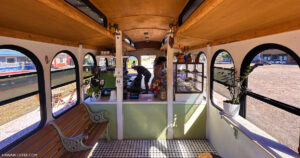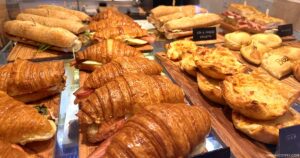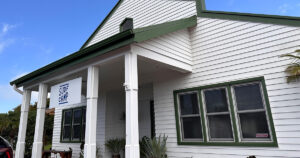From French Press To Chemex: How To Brew Your Hawaiian Coffee At Home
There’s no doubt about it: A great cup of coffee starts with the bean—and there are few beans as superb as those that come out of Hawaii.
Known for its velvety-smooth Kona coffee—as well as an escalating number of specialty blends—the 50th state has garnered a reputation as one of the finest coffee suppliers in the world.
And yet, beans are only one part of the equation: How you brew that bag of Hawaiian (or other) coffee plays a huge role in the quality of your cup of joe.
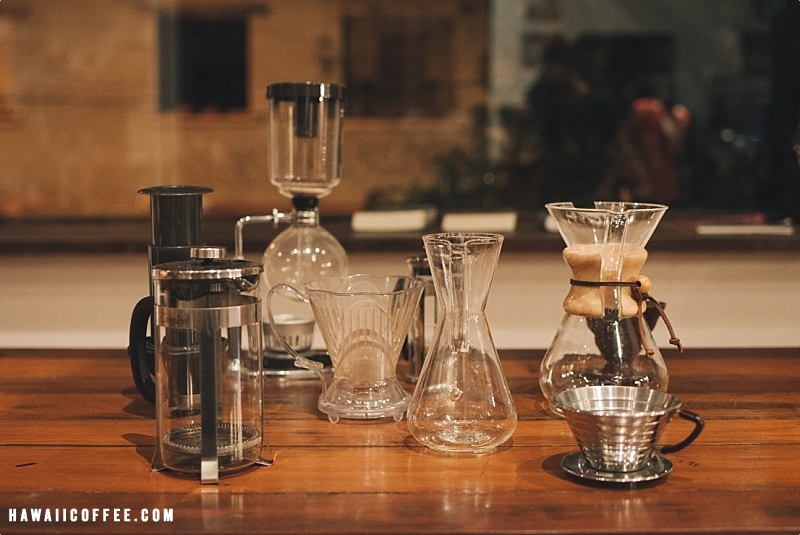
With this in mind, we’ve broken down the best ways to brew your aloha gold at home:
Pour Over/Drip
It’s enticing spotting a cone over a pot or cup of coffee as if you’re catching something delicious in the making. The Pour Over/Drip method is simple, quick, and efficient, as all it takes is pouring hot water over coffee grounds in a filter that’s ensconced in a cone. The brewed java then drips into a mug or pot, granting you a cuppa pronto.
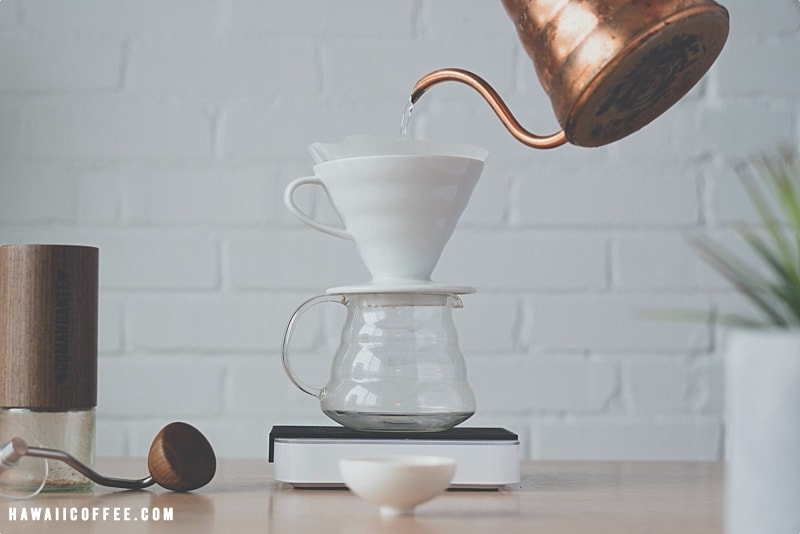
Pros: The brewing time is a scant one to three minutes, and the flavor pour-overs produce is generally smooth with a round body. Further, this method is excellent for bringing out the bright flavors often present in Hawaii-cultivated coffee.
Cons: Unless you have a large pot—and an equally large cone—pour-over/drip coffees typically produce only a single cup. Meaning? Perhaps not the most sensible choice for your next family brunch. This method also requires paper filters, which, naturally, need to be replaced each time you brew.
Keep in mind: …that, when using this method, your beans will need to be ground down to a medium-fine, coarse texture. In addition, the shape of the cone you choose—as well as the filters—will influence your brew’s flavor.
Chemex
The elegant glass flask used in this pour-over variation was developed by German chemist Dr. Peter Schlumbohm in 1941, which indicates that this machine has withstood the test of time. Relying upon a paper filter that’s 20-30% heavier than standard filters, a Chemex requires little more than pouring hot water over ground beans. The brew then drips into the flask, which doubles as a carafe.

Pros: Chemex-brewed coffee delivers balanced, clean cups of coffee, which makes it a solid choice for those who prefer to savor the crisper notes of Hawaiian coffees.
Cons: Chemexes demand a higher price tag than other brewing tools, and its glass is, of course, fragile.
Keep in mind: …that a Chemex needs to be cleaned with a special brush. It also requires Chemex-specific filters.
Moka Pot
Happen to have purchased your Hawaiian coffee ground into the texture of fine sand? Consider using a Moka pot. Consisting of eight sides, and coming in both stove-top and electric styles, this tiny wonder was produced by Italian engineer Alfonso Bialetti in 1933—and quickly became a staple of Italian culture. Often referred to as “stovetop espresso,” a Moka pot delivers coffee through three basic chambers and the simple act of listening to when the top compartment is filled with concentrated coffee (keep your ears peeled for its telltale gurgle).
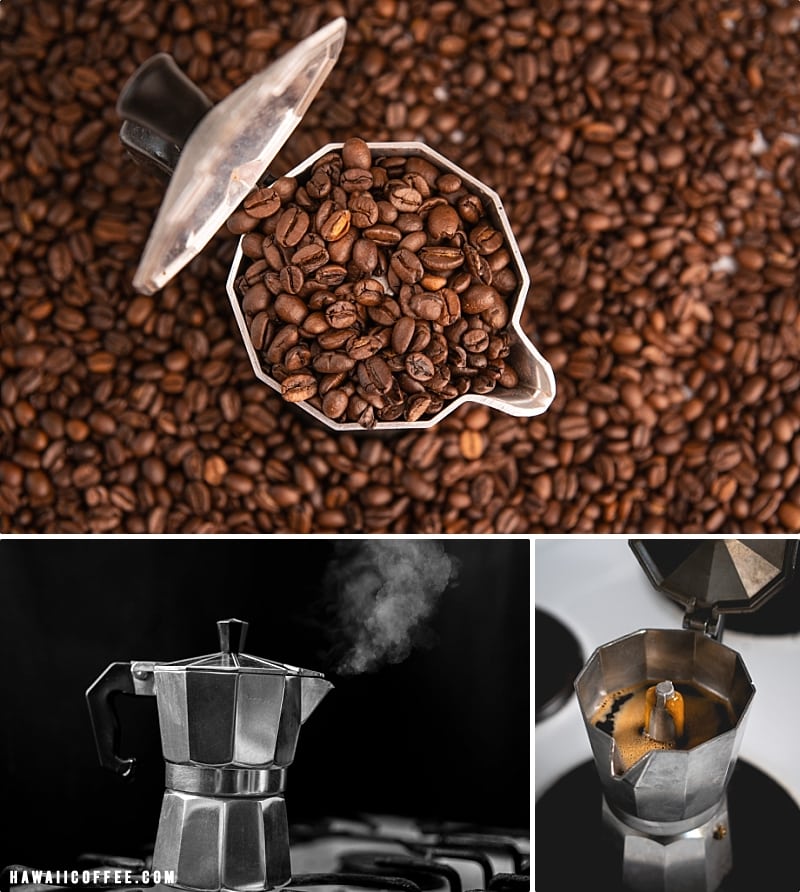
Pros: A Moka pot is portable and economical, and if you like your coffee thick, rich, and strong, then this brewing method is for you.
Cons: Perfecting java in a Moka pot requires skill and time. Translation? At first, the quality of your cuppa may vary from brew to brew.
Keep in mind: …that if you’d like to relish the mellow vibes of Kona coffee, a different brewing method may be to your benefit: Again, a Moka pot produces a denser, lusher result.
French Press
Deemed an immersion-brew process—in that coffee is fully immersed in water during the process—French Presses are considered one of the finest tools in the (coffee) trade. Made of a cylindrical pot with a plunger and a built-in filter screen that presses hot water through the ground coffee, it creates a brew that contains more oil and grit than filtered coffee—a major boon for those who love their java with a little texture. Additionally, the process of French Pressing helps underscore the more full-bodied, chocolatey notes in coffee, rendering the method a particularly smart option for the luscious and fudgy, Hawaiian-made Maui Mokka.
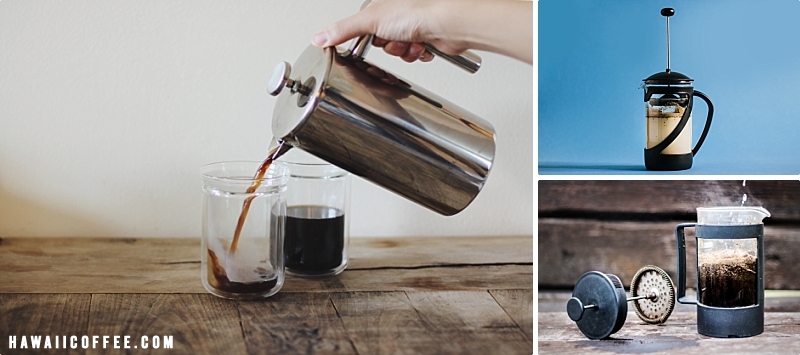
Pros: Your French Press can produce more than a hot cup of coffee—it can also be used to make Cold Brew. (Prepare your coffee as usual, but use room-temperature water in the press instead; then, let the coffee chill in your refrigerator until you’re ready for a refreshing sip.) Also, you can control the brew time—and, thus, the strength and taste.
Cons: You’ll need an electric or old-fashioned kettle on hand to heat the water required (microwaves, in this case, are a no-no). Further, brewing your coffee in a French Press means that you need to stay attentive: Over-extract the grounds and you may have a cup that resembles dishwater.
Keep in mind: …that a French Press requires a higher initial investment than your Mr. Coffee. That said, a French Press doesn’t require paper filters, either.
Drip Method
Speaking of the devil: That Mr. Coffee is a perfectly acceptable way to brew your Kona or other Hawaiian coffee at home; after all, your grandmother probably used an automatic machine for years. The cost of these coffee pots is low, and brewing requires no more effort than filling a filter with ground beans, pouring in tap or filtered water, and pressing start.
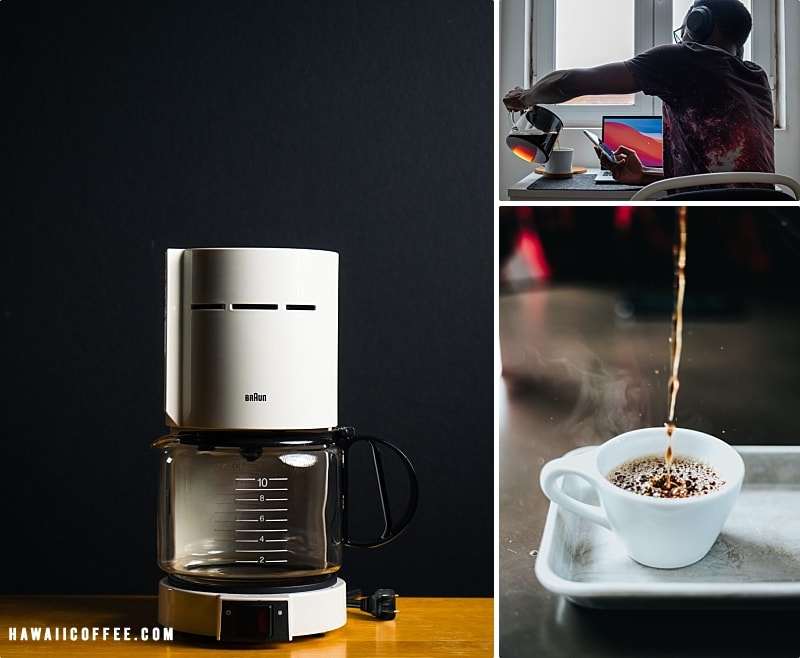
Pros: You can set it and forget it, freeing up your life for other pursuits. You can also pre-set your drip coffee pot so that a hot cup of java is waiting for you first thing in the morning.
Cons: A drip coffee maker can only do so much, and, according to aficionados, wastes your specialty beans—Hawaiian or otherwise.
Keep in mind: …that while you can brew up to 12 cups in a Mr. Coffee (or a similar, automatic drip system), you’ll find the most quality brews in smaller batches.
AeroPress
Developed in 2005 by Aerobie president and inventor Alan Adler, the AeroPress puts its name to the test: Coffee is steeped for 10 to 50 seconds. Air pressure is then used to force coffee through a paper filter at one end and directly into a mug. Out of this, you get a cup that’s wonderfully smooth and dependably pleasant.

Pros: Happen to take your coffee tools on the road? Then this home-brewing method is for you: The BPA-free plastic bottles can survive both camping trips and backpacking holidays.
Cons: This machine is made for solos on the go: Designed to hold 6 to 8 ounces, they’re the ideal tool for singles. Have a whole household of caffeine fiends? Not so much.
Keep in mind: …that, while an AeroPress shares similarities to the French Press method described above, it has its distinctions too. An AeroPress depends on a filter, and paper filters are largely used. This means that the cup that’s produced contains less oil than a French Pressed-mug (and the body that comes with it). On the other hand? An AeroPress, which doesn’t generate the grit that stems from French Pressed cups, also doesn’t muddy a bean’s organic flavors. This makes them a particularly wise choice for any Hawaiian coffee you may have chosen, which, much like the islands themselves, typically contain sunny, dazzling tones.
